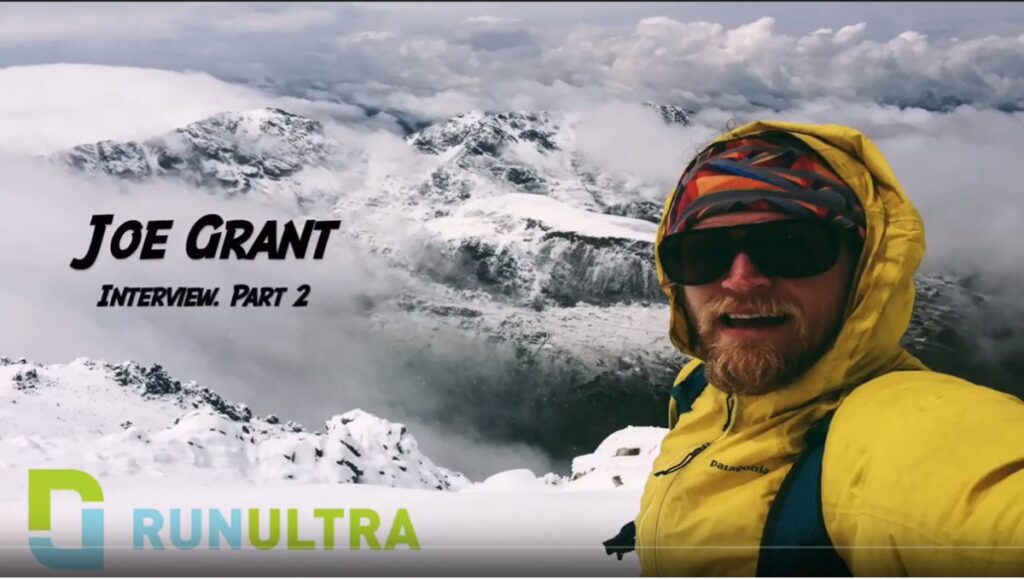Running into Trouble and out of Injury
As race prep goes, not running for two months before an ultra marathon was substantially less than optimal.
At least I had a plan – stash a £20 note inside my phone case so that I could jump a taxi if the proverbial wheels came off.
I knew the uphills would be fine; push until the tap-tap becomes a grind. And then just continue moving. Movement beats standing still and I was confident stamina would get me through a long day, even if lack of training meant didn’t have ‘speed’ in my legs.
But as I stood on the start line of the Pen Llyn Winter Ultra a week into November, it was the downhills that were causing most fear.

Start of the Pen Llyn Ultra: photo Garry Doolan
At the start of September, during consecutive ‘easy days’ after a holiday in Crete, I crashed to the tarmac without any apparent warning. On both occasions, I was approximately four miles in to my run, cruising downhill on simple footpath.
There here had been no one, clear warning for this obvious disaster. But there had been subtle signs. I had just been too pig-headed to heed them.
In July, I had made the gut-wrenching decision to pull out of the Dragons Back Race. I knew that I wasn’t in the right shape to go hard for six consecutive days.
I was just so bloody tired. Motivation had slumped and my knees still hurt after doing quite well – for a 50-year-old – in the mountainous GB Ultras Wales 50 in June. My left Achilles was angry and somewhere inside my right hip there was a miserable, dull ache.
In hindsight, I don’t think I had truly, fully recovered from completing the Arc of Attrition in January.
Within days of getting back from Cornwall, and focused on the Dragons Back as my big race for the year, I had thrown myself straight back into training.
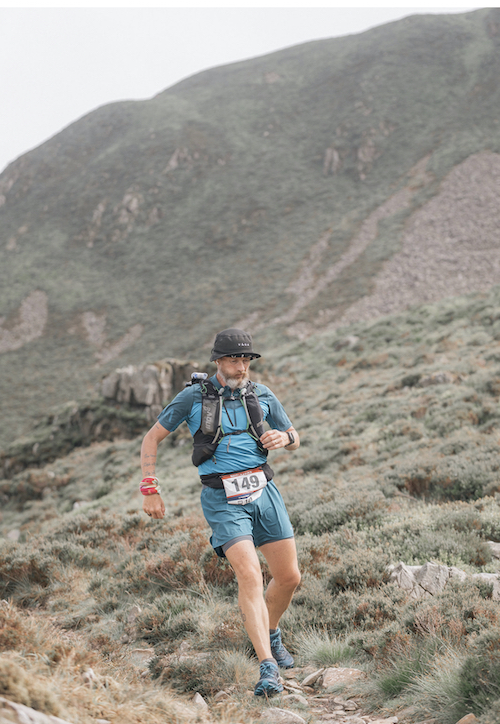
GB Ultras Ultra Wales 50: photo credit GB Ultras
I didn’t feel over-trained as I ticked off high-mileage days in Snowdonia and the Peak District throughout the rest of winter and early spring. Obviously, I was tired and sore as miles ramped up, but kidded myself the aches and pains would sort themselves out if I stacked even more training on top.
Of course, that was folly. And there had to be a reckoning.
It came four miles into that inconspicuous late summer jog down an urban footpath.
The day before, my leg had given way without warning. I picked myself up, plucked dirt and gravel out of cuts on both knees and skipped back home. I was probably lucky to be alive; I had tumbled into the road – but the traffic was stationary because of roadworks. It was no drama. I assumed I had simply tripped on loose stones or a stick.
I was okay. Until the next day.
Same thing. Four miles into a comfortable loop around the neighbourhood, running downhill. Bang. This time there had been a pre-emptive twinge in the right glute. I had taken a couple of strides. then smashed to the floor.
Within a couple of hours, I was sat in front of my GP trying desperately to avoid being frog-marched to A&E.

Pen Llyn Ultra: photo Garry Doolan
Actually, I was lying prone with my trousers around my ankles while the doctor satisfied herself that I still had feelings and function in ALL the areas around my hips. I wasn’t numb and peeing myself which, apparently, would have made it really problematic!
After tickling bits that only a wife or loving partner should tickle, she was happy with the outcome of her cotton wool test, but didn’t have an answer to the main issue in hand. She didn’t think it ideal for anyone to be running 50 to 60 miles a week, but accepted my counter-argument that humans had been covering long distances on foot for millions of years to catch food.
She referred me to an NHS physio, but could not offer other significant help if I wasn’t prepared to drag myself immediately to A&E.
I was not keen to inflict that on myself after my experience at hospital a few months earlier when an infected blister from a flat 50-mile race left me unable to walk. I had festered for hours in the waiting room as my precious weekend evaporated away.
So I headed home from the GP, spent a couple of days taking stock, then booked in to see my own physio.
Incredibly, he had the answer – well, a possible answer – within minutes.
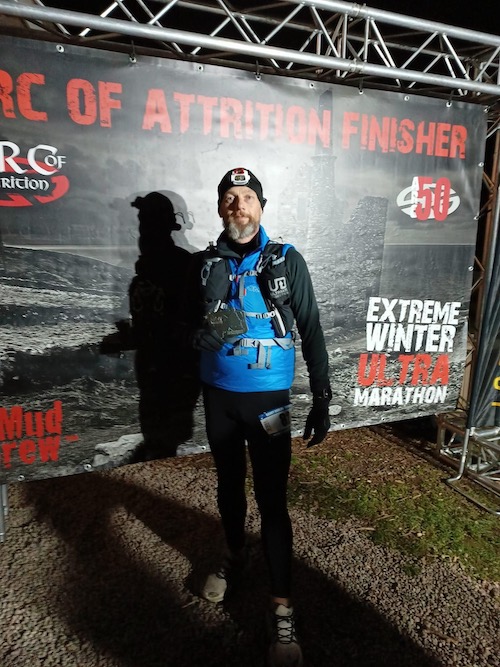
Arc of Attrition: photo Garry Doolan
My glutes weren’t working properly, he thought, various muscles on the right side weren’t doing their job and the sciatic nerve was firing more than the hamstring. My Garmin had previously highlighted a five per cent inequality between ground contact from left to right. But I hard largely ignored it, until now, when shit had hit the fan.
The physio sent me on my way with a dose of sympathy for ‘important’ races about to be missed and a couple of simple exercises to teach the lazy hamstring the error of its ways.
But there was a nagging doubt in my mind about possible nerve damage. I simply didn’t believe the solution to losing the function in my legs could be easily fixed with a couple of rehab exercises.
I could fill the next few hundred words with tales of MRI scans on lumbar spine, strained discussions with an NHS physio who ‘had never seen the likes before’ and a visit to a BUPA GP in an attempt to circumvent the grinding misery of the NHS for an active person who just wanted to get back out.
I put on more than a stone and a half in weight as the usual weekly mileage fell away to zero over a period of just six weeks.
And the wife stopped humouring my new-found fetish for cotton wool balls in sensitive places as I became increasingly difficult to live with. That’s a figment of my imagination; but the family certainly suffered as my mood increasingly darkened as much as the days as we drifted into autumn and races fell away one after the other. I dropped first from Centurion’s new Winter 200 then pulled out of Mark Cockbain’s Track 100 at the end of October.
I managed a couple of tentative, slow jogs on a beach, just in case I fell to the floor again.
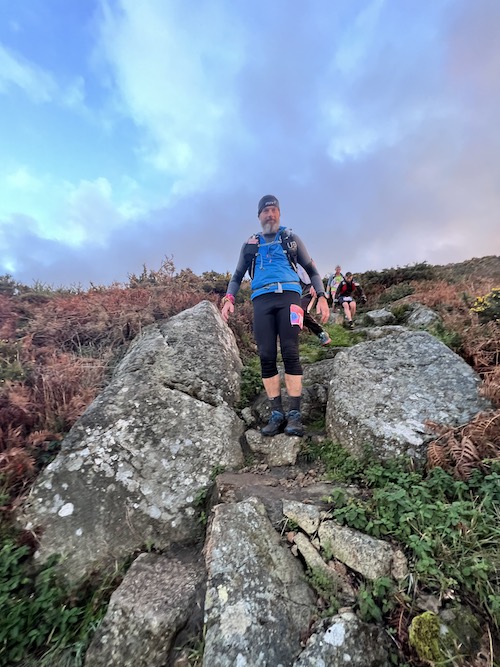
Pen Llyn Ultra: photo Garry Doolan
And I rescued my old mountain bike from the back of the garage for a bit of ‘cross training’. But the reality was that I was just cross.
More than that. I think I had started to grieve. For running. For the horrible pleasure it brings. For the social cohesion. For the smugness that comes from being able to run eight or ten hours on a few flasks of Tailwind and a couple of chunks of melon. For the warm afterglow after running a huge distance across inhospitable, trackless terrain. ‘Normal’ people are in awe of what we do – and I love that.
I stopped watching running videos on YouTube and certainly stopped fixating on ultra running. I had only just begun a 24-week training plan for The Tunnel when my legs gave out; my spirit got shittier as the weeks for building good, steady miles drifted past one by one.
I consulted gurus and gobshites in equal measure in the hunt for an explanation I could truly believe in; there is no shortage of charlatans willing to take a buck or two in exchange for useless info that has little, if any, basis in medical fact.
I flew to Belfast for an in-person strength and mobility coaching course with a chap called Tom Morrison; most definitely ‘guru’ and worth every penny.
I also hovered over booking flights to Helsinki to see a Twitter-witterer with apparent expertise in running rehab.
There was, quite frankly, no length to which I would not go. And no expense was spared.
If there’s anything more expensive than ultra running (kit, nutrition, entries, travel, hotels) it’s not running ultras (physio, scans, compression boots, turmeric capsules, luxury testicle cream made from the freshly-squeezed tit-juice of a lactating, grass-fed wild rhino).
There is no end to the shite you believe when desperately seeking a route back. Some of it helps a little bit some of the time. And something is better than nothing.
But the futility of the vicious circle I was stuck in was thrown starkly into focus by a simple social media post from the aforementioned Tom Morrison.
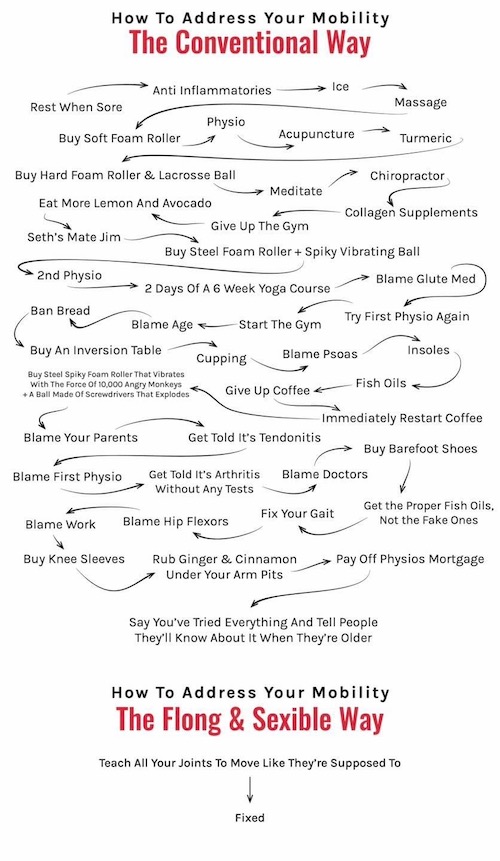
Image courtesy Tom Morrison
It was a tongue-in-cheek graphic that neatly captured the desperate progression that myself and other injured runners go on. It included a list if things like sports therapist, turmeric, stretching, foam rolling, back to physio, run a few miles to ‘test’ the injury, have a couple of weeks off, chiropractor, back to physio, testicle tickling by a GP (not quite, but almost).
Laid out like that, it looked ridiculous. And I pretty much had the ‘full house’. I laughed. And could have cried. I printed it off, pinned it to my office wall and vowed never to be so gullible again.
With Tom’s post in the back of my mind as the weeks rolled on, I started to really examine where it had all gone wrong. In a moment of clarity, that shone light on where it had actually gone right.
And I had to go back to the Arc.
The final 30 miles of that race had forced me to accept that I wasn’t actually very strong in critical areas. Sure, I was cardio fit; I toed the line with a realistic target to go sub-24 hours. But that optimism had been smashed somewhere between Lands’ End and St Ives.
The poles had come out and I was a mess for the final 20 miles.
While I nursed the tingling in my feet and the loss of some toe-nails for a few weeks, I resolved to get strong and spent the next couple of months adding gym work to my running. I hadn’t really bothered before, kidding myself that time on feet was enough to build strength.
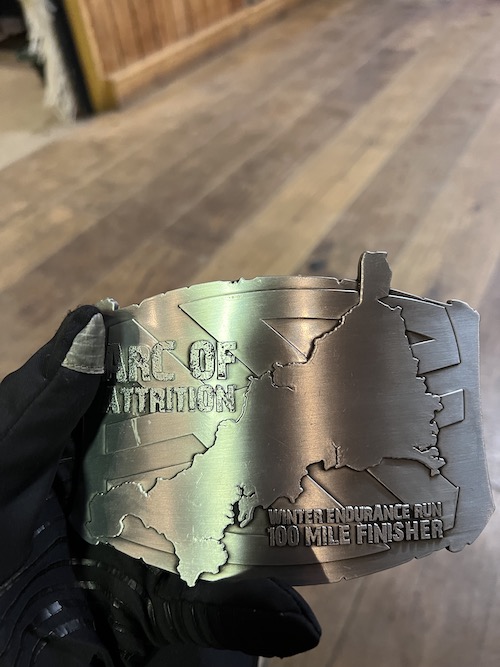
Photo Garry Doolan
When I look back now, that sustained period of gym work was chipping away at the aches and niggles. For the first time in a long time, I was running almost pain free. Even running twice a day sometimes.
Then, because I wasn’t hurting so much, I stopped the strength work. I stopped taking the medicine.
And that’s it, right there. The reason I was on my arse in a gutter five months later.
I always knew the logic: Strength, conditioning and mobility bullet-proofs a runner’s body; targeted strength training reduces injury rates by as much as 85 per cent etc etc.
But I hadn’t whole-heartedly bought into it. Until now. Until presented with the real and present danger that my ultra running could be gone for ever.
That was the critical difference this time; I wasn’t nursing just another calf injury or a bit of knee pain. I really feared it could all be over. Which put me in a very dark place.
I created a mini-gym in my garage, mashed together a couple of strength routines and added specific exercises recommended by the excellent Irish marathon runner Stephen Scullion.
I experimented, but that experimentation was consistent. Critically, it exposed weaknesses which I worked on minus the distraction of running.
Which brings me right up to date with the ‘Beautifully Brutal’ Pen Llyn Winter Ultra on a glorious Saturday in November.
I hadn’t officially entered, but took a chance on a few no-shows and got the nod to compete just half-an-hour before the 7am start.
It was shit or bust. But it felt right to have a go.
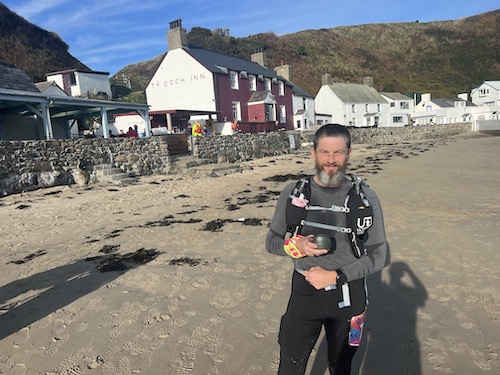
Photo Garry Doolan
As the miles ticked by, the fears melted. Running in heavy mud, wet sand, uphill on concrete, downhill on rocky trails, downhill on grass. The hip. The nerves. The spine. Whatever. They all checked correct.
This fantastic race finishes with a six-ish mile descent into Pwllheli. And I knew that was where it could really unravel. This road back to the coast best approximated the terrain of my double-collapse at the start of September. And the proceeding 30 miles would ruthlessly expose any weakness.
Three miles from the finish, I was still upright, clipping along hours ahead of my predicted finish and singing loudly in step with a song called ‘Waterfall’, by the band James. To do almost 40 miles without my legs giving way lifted the anxiety and banished the demons.
And my post-race behaviour suggested that I may have actually learned my lesson.
I ate fish and chips the next day, with bread, followed by a cake chaser. Carbs were most definitely on the menu for a couple of weeks. No ruthless calorie-counting. I can compete without keto.
I didn’t feel the pressing need to immediately get back running. But I did hit the gym for stretching and mobility and enjoyed a couple of lengthy saunas.
Grudginly, I also accepted that the doctor may have been a bit right when she held my running balls in her hand, so to speak.
Ultras can be unhealthy, they’re not natural and possibly – probably – not great for the body. But running long distances is amazing for the soul.
Critically, then, there must be balance.
Balance in training, balance in nutrition, balance in recovery and balance in home life. I can afford to relax a bit. I’ve noticed in the last couple of months that without the massive miles, my VO2 max has gone down but my HRV has gone up.
By kicking back, I can actually kick on.
Garry Doolan lives with his family on The Wirral – close enough to Snowdonia and the Lake District to think he should run in both more often. Having completed the Arc Of Attrition earlier this year, he was forced to pull out the Dragon’s Back Race with injury. Now his sight’s set on The Tunnel in March.
Header image: courtesy GB Ultras
Beyond the Ultimate Mountain Ultra – Kyrgyzstan

